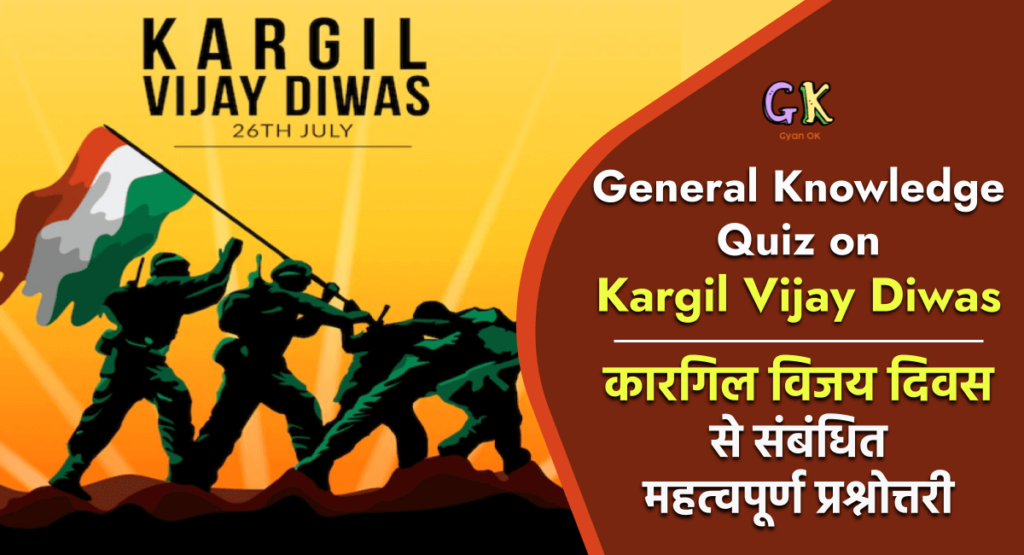Kargil Diwas is a day of great significance when we pay tribute to our courageous soldiers who showed exceptional courage in the challenging Kargil region. It fills us with a deep sense of pride and a touch of joy as we reflect on their sacrifices and the ultimate victory achieved. In this article, we have prepared an engaging quiz to test your knowledge of Kargil Diwas and the remarkable individuals who played pivotal roles during that period. Join us in commemorating their heroism and ensuring that their legacy endures.

General Knowledge Quiz on Kargil Vijay Diwas
Kargil Vijay Diwas, observed on July 26th, commemorates a pivotal moment in India’s military history. It recalls the successful conclusion of the Kargil War in 1999, a conflict that unfolded in the high-altitude mountains of the Kargil region in Jammu and Kashmir. This day honours the exceptional valour and sacrifices of our armed forces who valiantly defended our nation’s sovereignty against infiltrating Pakistani forces. Kargil Vijay Diwas resonates with every Indian as it underscores the unity, resilience, and unwavering spirit of our nation in the face of adversity.
Thus, we have prepared a brief quiz on the topic for you to access your knowledge and learn something new through the process.
[–MCQ-QUESTIONS-DISPLAY–]
Why is Kargil Vijay Diwas Celebrated?
Kargil Vijay Diwas is celebrated to mark the successful conclusion of the Kargil War in 1999, a critical chapter in India’s history. This observance, held on July 26th each year, holds great significance for the nation. The war began when Pakistani forces infiltrated Indian territory in the Kargil region, violating the Line of Control (LoC) that divides the two countries in Kashmir. India responded with determination, and our brave soldiers engaged in intense battles in challenging terrain, facing harsh weather conditions and well-prepared enemy positions.
This commemoration serves several important purposes. It honours the sacrifices made by our armed forces during the war, paying tribute to those who gave their lives and those who displayed extraordinary courage under trying circumstances. It also reaffirms India’s commitment to defending its sovereignty and territorial integrity. The successful outcome of the Kargil War was a testament to the nation’s unity and resolve.
Furthermore, Kargil Vijay Diwas reminds us of the importance of diplomacy and peaceful resolution of conflicts, highlighting the need for international norms and agreements to prevent such situations in the future. It also educates younger generations about the history and sacrifices associated with the Kargil War, fostering a sense of patriotism and respect for our armed forces.
How Did India Win the War of Kargil?
During the Kargil War of 1999, Pakistani militants, with the support of the Pakistani military, infiltrated Indian territory in the Kargil sector strategically and covertly. Their infiltration was a carefully planned operation that aimed to take advantage of the rugged and mountainous terrain in the region. Here’s a brief overview of their strategy and how India combated the situation:
- Pakistani militants, many of whom were regular soldiers in civilian clothing, infiltrated into Indian territory during the winter months when most of the Indian posts were vacated due to the harsh weather conditions. This allowed them to occupy advantageous positions before Indian forces could detect their presence.
- The infiltrators strategically occupied key heights and vantage points along the Line of Control (LoC). These positions gave them a significant advantage in terms of surveillance and the ability to target Indian military positions and supply routes.
- They constructed well-fortified bunkers and camouflaged them to blend into the surroundings. This made it challenging for Indian forces to spot and neutralize them.
- Pakistani militants used mortars and artillery to shell Indian positions and nearby civilian areas. This not only posed a direct threat to Indian troops but also created panic among the local population.
India’s response to this situation that marked tremendous bravery and strategic decisions leaving a significant mark on history.
- India adopted a well-thought-out military strategy to recapture the occupied heights and evict Pakistani militants. This strategy involved a combination of ground operations, artillery barrages, and airstrikes.
- Indian infantry units were tasked with the challenging mission of retaking the high-altitude positions held by the infiltrators. These operations required soldiers to engage in hand-to-hand combat in rugged and inhospitable terrain. The Indian Army displayed remarkable bravery and tenacity in these battles, gradually pushing the enemy back.
- Indian artillery and mortar units played a critical role in the conflict. They provided crucial firepower support, shelling Pakistani positions and disrupting enemy supply lines. This artillery fire was instrumental in softening enemy defences before ground assaults.
- The Indian Air Force (IAF) played a decisive role by conducting precise airstrikes on enemy positions. The IAF’s ability to strike at high altitudes in the mountains was a significant advantage. The air raids not only inflicted casualties on the infiltrators but also destroyed their bunkers and fortifications.
- The Indian Army had to overcome significant logistical challenges due to the remote and high-altitude terrain. Supplies had to be transported through narrow and treacherous mountain roads. Despite these challenges, the Indian military ensured that troops were well-equipped and adequately supported.
- India diplomatically isolated Pakistan on the international stage by presenting evidence of Pakistan’s involvement in the infiltration and aggression. The global community condemned Pakistan’s actions and exerted diplomatic pressure on them to withdraw their forces.
- India exercised strategic restraint by limiting the scope of the conflict to the Kargil sector. This approach was aimed at preventing the escalation of the conflict into a full-blown war and maintaining the focus on the Kargil theatre.
